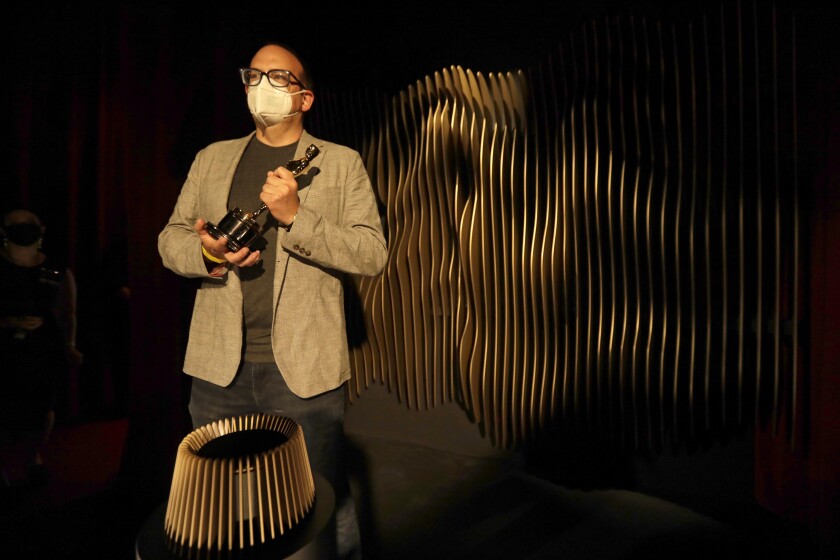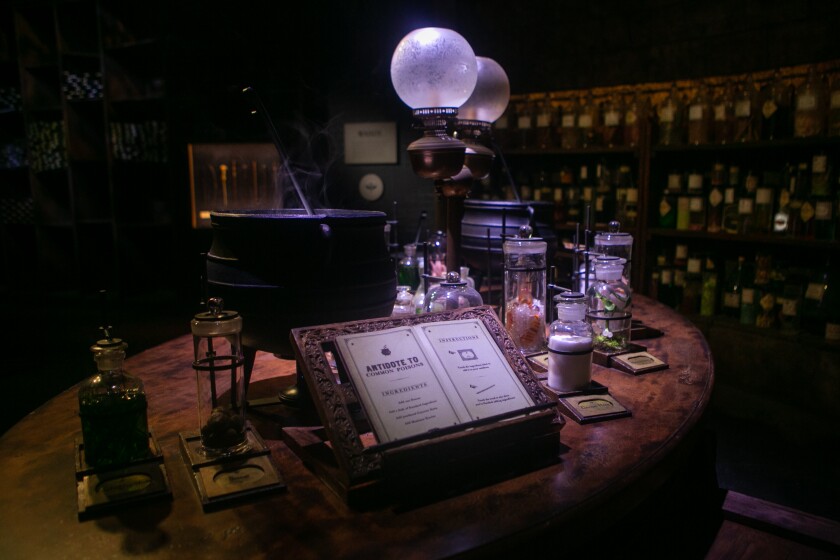My Oscar was in sight. A producer instructed me where to stand. Before me and the statuette was a curtain as I awaited my cue to rush to the stage.
I didn’t write a speech — of course — but multiple options raced through my head. Do I keep it safe and boring and limited to thank-you’s? No — no one wants that. I would definitely talk about the importance of getting a vaccine, that’s for sure. And then? Recent political events seemed worth addressing, and no doubt that would garner some attention on social media … if I were actually winning an Oscar and not just pretending.
I was up. “Congratulations,” shouted an Academy Museum staffer playing the role of a producer as applause swelled from the audience before me on a screen. Lights brightened, and I momentarily squinted as I reached for the Academy Award. The crowd, a recording lifted from an Oscar telecast at the Dolby Theatre, seemed to only get louder as I took a breath before beginning my gracious words of acceptance …
Uh-oh — now I was hearing the music become more deafening. But my speech! The importance of vaccines! The risk to the constitutional rights of women!

Los Angeles Times reporter Todd Martens holds an Oscar while taking in the Oscars Experience at the Academy Museum.
(Genaro Molina / Los Angeles Times)
I was whisked off stage, where the Oscar was left behind for the next paying guest ($15, on top of admission to the Academy Museum, for the Oscars Experience video opportunity). My brief moment in the spotlight, a two-minute simulacrum of what is a showbiz dream for many, had come to an end. Emailed to me would be a clip of my seconds on a makeshift Oscar stage, which will have to do unless my life’s fortunes change.
Remember theme park or carnival souvenir photo ops that would slap a guest’s face on a popular magazine? Think of the Oscars Experience as a slick, high-tech version, in which multiple cameras will film a moment with professional stage lighting that looks fit for prime time — or at least sharing on social media. There’s an underlying goal of promoting the Oscars, but if lighting and framing can make the guest look and feel glamorous, all the better.
When the Academy Museum opens on Sept. 30, it will do so with exhibits that look at Oscar and cinema history, including a deep dive into the works of Japanese animation legend Hayao Miyazaki. But the Oscars Experience is an upsell venture that brings ever-so-slight theme park trappings to the museum, furthering an immersive entertainment trend that shows that even education institutions today need to deliver their messages with a few spoonfuls of sugar.
Increasingly, any attraction, museum or art space seems ripe for lessons from the themed entertainment industry.
“I’ve worked in a bunch of different museums for a very long time, and what I’m learning — the more that I work in them — is that we’re starting to adapt and evolve,” says Lauren Girard, the Academy Museum’s head of visitor services who previously held a similar role at the Broad.
“We’re starting to acknowledge that people learn in different ways,” Girard says. “There are people who learn by reading, people who learn by listening and then there are people, myself included, who are ‘tactilers’ and want to experience something and hold onto an object or pull a lever. That’s a valid way of learning and exploring. I’m excited by the way museums are pivoting rather than being like, ‘Let me impart information upon you.’”
Large museums have always possessed an air of theatricality. When I was a child, Chicago’s Museum of Science and Industry held a similar space in my brain as Walt Disney World did, thanks largely to its ride-like coal mine experience. Here in Southern California we’re accustomed to fantasy and larger-than-life environments, be it one of our area theme parks or the Pompeii re-creations of the Getty Villa — an art theme park, more or less.

An Oscar rests on a podium so visitors can lift it as if they had just won the Academy Award as part of The Oscars Experience at the Academy Museum.
(Genaro Molina / Los Angeles Times)
The Grammy Museum allows guests to experiment with record production, and recently the Warner Bros. Studio Tour was revamped with theme park-like trappings, including a host of interactive “Harry Potter” exhibits that wouldn’t be out of place at Universal Studios’ Wizarding World of Harry Potter. Indeed, the updates to the Warner Bros. jaunt were handled by Thinkwell, a local firm known best for its contributions to theme parks around the world.
Thinkwell creative executive Cynthia Sharpe started in museum spaces more than two decades ago and has seen them branch into the worlds of tech to today attempting to create more all-encompassing environments. “You can’t say we’re just going to have a white box with some touch-screen kiosks,” Sharpe says of modern business and audience demands. “That’s not going to fly.”
Warner Bros. Studio Tour marketing executive Gary Soloff concedes that the new additions to the experience, including interactive re-creations from the “Harry Potter” and “Batman” films, many of which are peppered with real props amid the playful photo opportunities, could fall somewhere between a theme park and a museum, indicating that entertainment and educational lines are being blurred.

Warner Bros. Studio Tour guests can try their hand at mixing potions from the “Harry Potter” franchise.
(Jason Armond / Los Angeles Times)
“I think you’re going to have some creators of more traditional experiences that are disappointed in [these newer experiences],” says Carissa Baker, an assistant professor with the University of Central Florida who writes about theme parks as artistic spaces.
“There was a different approach to the design of these places in the past,” Baker says. “The artifact itself was the thing that mattered, but then we started getting to setting. What’s the setting? I can’t think of a better example of that than the Getty Villa. That is a themed space. But those artifacts, in that space, feel more authentic, which is ironic, because they are authentic — but I feel immersed in that space, in a traditional environment that created that art.”
If once we had to travel to a Disney or Universal theme park, today more regional experiences — from the floor-to-ceiling installations of art collective Meow Wolf, which now has locations in Las Vegas, Santa, Fe, N.M., and Denver, or the City Museum of St. Louis — are bringing story-driven immersive experiences to a wider audience. That creates industrywide pressure, where an exhibit that re-creates the sensation of winning an Oscar, something that once may have been more of a piece with Universal Studios or Walt Disney World’s Hollywood Studios, is now just as at home in an educational facility.
“The aspirational element has created increasing expectations,” Sharpe says. “Think of what it was like to walk into a restaurant or a coffee shop a couple decades ago versus what it is now. Our expectations have changed. It’s not just the food. It’s the design. We comment on the plates, the design, the soundtrack. Our expectations of experiences have been turned up to 11.”
It’s no wonder, then, that the Academy Museum’s Girard references Disneyland when walking through the Oscars Experience, specifically the fan-created event Dapper Day, in which guests role-play in period-specific costumes. Someday, she says, she hopes the Oscars Experience will inspire cinema fans to show up at their most fashionable.
“I hope that visitors embrace the theatricality of the piece,” Girard says. “I would love to see visitors dress up in their Oscars best and come to do this experience. That would be the dream.”







